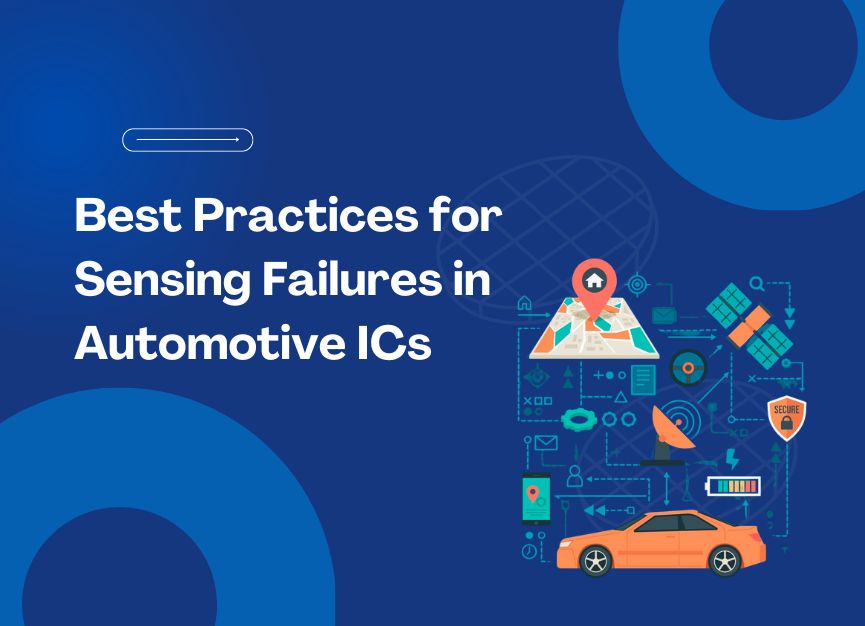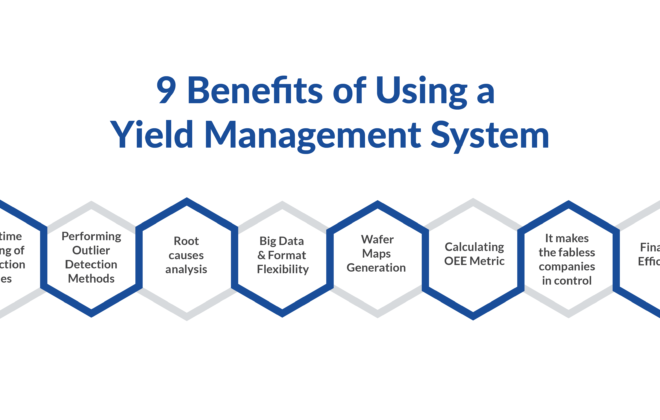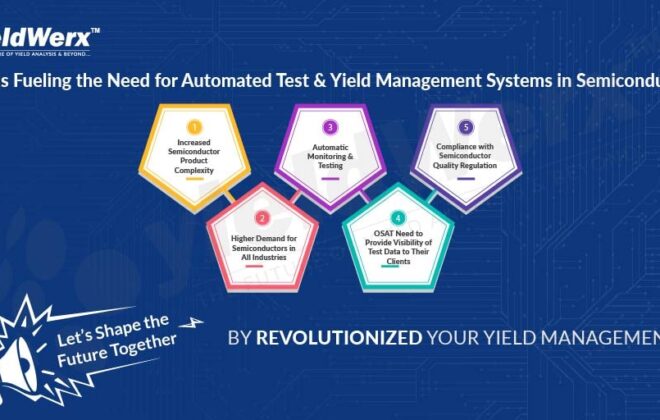Best Practices for Sensing Failures in Automotive ICs
The integration of semiconductor integrated circuits (ICs) in automotive systems has significantly advanced vehicle functionality and performance. These ICs are vital for a broad range of operations, from engine management to safety systems.
Given their importance, the industry’s focus has shifted towards developing sophisticated methods for detecting and sensing potential failures early on. This proactive approach is essential for maintaining the safety, reliability, and performance of vehicles, as it allows for the identification and mitigation of issues such as thermal failures, voltage fluctuations, and electromagnetic interference before they escalate.
Importance of Failure Sensing in Automotive ICs
The critical role of failure sensing in automotive ICs can’t be overstated, with direct implications for safety, reliability, and cost-effectiveness in automotive applications.
Safety Implications
Failure sensing is vital for identifying potential hazards such as thermal failures, voltage fluctuations, and electromagnetic interference before they escalate into serious safety incidents.
Advanced sensor technologies and real-time monitoring play a pivotal role in this preventive approach, ensuring that vehicles remain safe for use.
Reliability Concerns
The dependability of a vehicle relies on the enduring performance of its semiconductor components. Aging and degradation over time pose significant risks to automotive IC reliability.
Implementing proactive failure sensing, supported by AI and ML for predictive maintenance, helps anticipate failures and mitigate their effects, thereby upholding the vehicle’s reliability and extending its service life.
Cost and Performance
Early detection of potential failures through effective semiconductor failure detection strategies, including sensor-based failure monitoring and advanced fault detection, can significantly reduce maintenance costs and downtime. Moreover, fault-tolerant designs and redundancy strategies ensure that vehicles continue to operate optimally, even when certain components are compromised, thereby enhancing performance without incurring unnecessary expenses.
Key Components in Automotive Semiconductor ICs
Automotive systems depend heavily on a range of semiconductor Integrated Circuits (ICs) for their operation. These components are key for the functionality, safety, and performance of modern vehicles.
Key components include sensors, processors, memory units, and power management ICs. These elements work together to manage vehicle operations, from engine management and safety features to infotainment systems.
Role of Sensors, Processors, and Other Integrated Circuits
Sensors play a critical role in gathering real-time data on vehicle status and external conditions, which processors then analyze to make instantaneous decisions. This sensor-processor interplay is foundational to advanced driver-assistance systems (ADAS), engine control units (ECUs), and other critical systems that ensure vehicle safety and efficiency.
The reliability of these components, underpinned by advanced sensor technologies and real-time monitoring, is non-negotiable for modern automotive design.
Impact of Failure in These Components on Overall Vehicle Performance
Failures in these semiconductor components can have a profound impact on vehicle functionality and safety.
For instance, thermal failures, voltage fluctuations, and electromagnetic interference can lead to the malfunctioning of critical systems, posing significant risks.
Implementing fault-tolerant designs, redundancy strategies, and predictive maintenance facilitated by AI and ML helps mitigate these risks.
Continuous monitoring and advanced fault detection are essential for maintaining automotive IC reliability and guaranteeing the vehicle’s performance remains uncompromised.
Common Failure Modes in Automotive Semiconductor ICs
Automotive semiconductor ICs face several typical failure modes that can affect vehicle performance and safety. Recognizing these issues is essential for creating strategies to detect, monitor, and address potential risks effectively.
Thermal Failures
These occur when ICs operate beyond their temperature tolerance, potentially leading to malfunction or permanent damage.
Effective thermal management strategies, including heat sinks, cooling systems, and thermal shutdown features, are essential to prevent these failures.
Voltage Fluctuations
Variations in power supply can cause operational issues or damage semiconductor components.
Voltage regulators and protection circuits are critical in managing these fluctuations for stable operation.
Real-time monitoring and predictive maintenance can further safeguard against the adverse effects of voltage instability.
Electromagnetic Interference (EMI)
EMI can disrupt the normal operation of semiconductor ICs, leading to errors or system failures.
Implementing EMI shielding techniques and designing circuits with EMI considerations are key to minimizing its impact.
Aging and Degradation
Continuous use can lead to the degradation of semiconductor ICs, affecting performance or leading to failure.
Employing predictive maintenance techniques, supported by artificial intelligence (AI) and machine learning (ML), allows for the early identification of aging signs, allowing timely corrective actions.
Adopting these strategies ensures ongoing monitoring and evaluation of semiconductor ICs for signs of failure.
Best Practices for Failure Sensing
To ensure automotive semiconductor reliability, adopting specific strategies is vital. These methods utilize cutting-edge technology to identify and mitigate potential failures efficiently.
Advanced Sensor Technologies
The use of sophisticated sensor technologies in vehicles is essential for accurately monitoring conditions that may lead to semiconductor failures.
These technologies form the backbone of detecting potential issues early by closely observing temperature, voltage levels, and electromagnetic activity.
Proactive System Health Monitoring in Real-time
Continuous monitoring of semiconductor ICs enables the immediate identification of irregularities, facilitating swift action to address any issues. This constant vigilance is key to preventing failures before they affect vehicle operation.
Fault-tolerant Designs
Creating systems that remain operational in the event of component failure is essential. Fault-tolerant designs ensure that a failure in one part does not compromise the entire system, maintaining function and safety.
Redundancy Strategies
Incorporating redundancy into semiconductor designs means adding backup components that activate if primary ones fail. This strategy is essential for keeping essential systems running, even when some components are not working as expected.
Techniques such as sensor fusion and outlier detection improve the ability to pinpoint and rectify potential issues promptly, keeping vehicles dependable and safe throughout their lifespan.
Challenges in Failure Sensing for Automotive Semiconductor ICs
Addressing the challenges in failure sensing for automotive semiconductor ICs involves overcoming several significant challenges inherent to the automotive industry’s operational environment.
Harsh Environmental Conditions
Automotive semiconductor ICs must operate reliably under extreme conditions. These include high temperatures, moisture, and vibration, that can lead to thermal failures, voltage fluctuations, and electromagnetic interference. Such environments challenge the effectiveness of failure-sensing technologies.
Integration Complexities
The complexity of integrating sensor technologies into automotive ICs adds another layer of difficulty.
Ensuring that these sensors can accurately monitor for failures like aging, degradation, and electromagnetic interference without compromising the IC’s functionality requires sophisticated design strategies.
Balancing Cost and Performance
Achieving a balance between cost and performance in failure sensing is a significant challenge. Implementing advanced sensor technologies, AI, and ML for proactive failure sensing and predictive maintenance must be cost-effective without sacrificing reliability.
Industry Standards and Compliance
Meeting industry standards and compliance requirements adds to the challenge. Automotive ICs must adhere to strict regulations, making the implementation of advanced fault detection, redundancy strategies, and real-time monitoring systems complex.
These challenges necessitate innovative approaches in semiconductor failure detection, including fault-tolerant designs, sensor fusion, and outlier detection techniques to maintain automotive IC reliability and ensure proactive semiconductor failure prevention.
Emerging Technologies in Failure Sensing
In the automotive industry, the evolution of failure-sensing technologies is essential for improving the reliability and safety of semiconductor ICs. Several innovative approaches are reshaping the field of failure detection and prevention.
Artificial Intelligence (AI) and Machine Learning (ML) Applications
Artificial Intelligence (AI) and Machine Learning (ML) are reshaping failure detection in semiconductor ICs.
These technologies improve predictive failure analysis and improve the detection of potential issues.
By processing extensive data, AI and ML identify patterns indicative of impending failures, thus improving the reliability of automotive ICs.
Cloud-Based Solutions
Platforms like yieldWerxTM offer advanced monitoring and maintenance capabilities through cloud computing. These solutions allow for real-time data analysis and centralized management of sensor information, facilitating early detection of potential failures across various systems.
Sensor Fusion for Improved Reliability
The integration of data from multiple sensors, known as sensor fusion, significantly increases the accuracy of failure detection.
This method is particularly effective in identifying thermal issues, voltage instability, and electromagnetic disruptions, providing a detailed overview of IC operational health.
Sensor fusion is key to developing designs that can maintain operation despite component failures, ensuring ongoing functionality and preventing system failures.
Case Studies
The following case studies and research demonstrate successful implementations of failure sensing in automotive semiconductor ICs:
Provocation tests and statistical modeling for delamination failure
A study published in IEEE Xplore discusses the use of provocation tests and the design of experiments to estimate product sensitivity to defects, specifically delamination failures in automotive semiconductors.
This research highlights the importance of understanding product sensitivity to defects and the development of models to analyze failures.
The lesson learned from this case study highlights the importance of understanding product sensitivity to defects and developing models to analyze failures.
This knowledge is important for designing durable and dependable automotive ICs, aiding engineers in identifying and addressing potential failure modes, like delamination, which can lead to safety concerns and product recalls.
Semiconductor Auto Multi Sensor Case Study
CyberOptics case study demonstrating the use of Fast Fourier Transformer (FFT) functions to analyze vibration in semiconductor manufacturing, which can help detect potential failures.
The lesson learned from the CyberOptics case study on the use of FFT functions to analyze vibration in semiconductor manufacturing is the importance of incorporating sensing capabilities into ICs to monitor their performance in real-world conditions.
This approach can help detect potential failures and improve product reliability, which is important for automotive ICs that operate in harsh environments and are subject to high levels of stress and vibration.
How can yieldWerx help in Failure detection?
By employing advanced outlier detection methods like PAT and GDBN, yieldWerx aids in failure detection, pinpointing anomalies in semiconductor IC manufacturing to ensure high-quality outputs. Here’s how:
Semiconductor Outlier Detection
Advanced outlier detection techniques like PAT and GDBN improve failure detection in semiconductor IC manufacturing by ensuring high-quality and reliable semiconductors. With its sophisticated algorithms, yieldWerx identifies anomalies early, promoting swift resolution and quality assurance.
Lot Genealogy
yieldWerx optimizes the tracing of semiconductor lot genealogy, from fabrication to customer returns, facilitating swift engineering analyses across manufacturing stages. This automation saves significant time otherwise spent on data retrieval, thereby expediting problem resolution and improving yield management.
Cross Work Center Correlation
Cross Work Center Correlation module empowers engineers to conduct root cause analysis for low yields, linking inline fab data with subsequent test stages. This tool by yieldWerx not only predicts final test failures but also confirms their causes, facilitating data-driven decisions for improving yield performance and operational efficiency.
Part Average Testing (PAT)
Part Average Testing (PAT) module by yieldWerx enables chip manufacturers to meet stringent zero-defect standards required in the automotive and high-reliability industries. By identifying outliers that deviate from normal behavior but pass standard tests, PAT ensures only the highest quality semiconductors reach the market. Offering both Static and Dynamic PAT, yieldWerx improves device reliability, reduces customer returns, and solidifies brand reputation through superior product quality.
Conclusion
The necessity for advanced failure sensing in automotive semiconductor ICs is critical to ensure vehicle safety and reliability. Adopting best practices such as real-time monitoring, predictive maintenance, and AI-driven diagnostics is essential. By prioritizing these strategies, we can significantly enhance automotive performance and prevent failures.
Check out how yieldWerx can assist in deploying these essential technologies for semiconductor failure detection and prevention.
Frequently Asked Questions (FAQs)
1. How do semiconductor failures impact automotive safety?
Failures in automotive semiconductor ICs can lead to critical malfunctions in essential systems like brakes, airbags, and steering, posing significant safety risks and potentially leading to accidents.
2. What are the most common failure modes in automotive semiconductor ICs?
Common issues include overheating, power supply inconsistencies, interference from electromagnetic sources, and wear over time, affecting component performance.
3. Can failure-sensing technologies prevent unexpected breakdowns in vehicles?
Yes, technologies for detecting failures early through continuous monitoring and maintenance forecasts can identify issues before they cause vehicle malfunctions, reducing the chance of sudden breakdowns.
4. What challenges does the automotive industry face in implementing practical failure sensing?
Integrating advanced sensors affordably, ensuring reliability under harsh conditions, and adhering to evolving standards present significant challenges in implementing effective failure detection systems.
5. How do artificial intelligence and machine learning contribute to failure detection in semiconductor ICs?
AI and ML are key in analyzing sensor data to spot patterns indicating potential failures, improving the precision of identifying issues early and allowing for preemptive action.
6. Are there industry standards for failure sensing in automotive electronics?
Yes, specific standards and regulations outline the testing and reliability requirements for automotive electronics, including failure detection and semiconductor reliability.
7. What role does predictive maintenance play in preventing semiconductor failures in vehicles?
Predictive maintenance is essential for spotting and resolving potential issues before they escalate into failures, thereby preventing semiconductor malfunctions and ensuring vehicle reliability.
8. How do environmental conditions affect the reliability of semiconductor ICs in automobiles?
Harsh conditions like extreme temperatures, moisture, and physical stress can accelerate component wear and increase failure rates, impacting overall semiconductor reliability in vehicles.
Recent Posts
- A Guide to Implementing Yield Management Software in the Semiconductor Industry
- Best Practices for Sensing Failures in Automotive ICs
- Why is Semiconductor Wafer Inspection Important?
- Multi Variant Part Average Test (MVPAT) for Refined Semiconductor Chip Manufacturing Analysis
- Wafer Map Calculators: Things You Should Know




